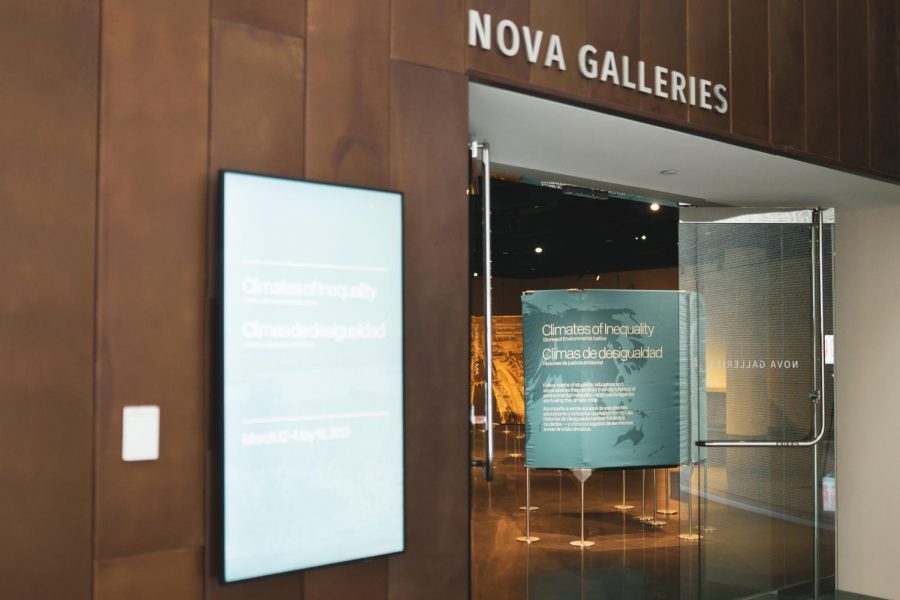Accordion-style panels fill up one of the gallery exhibition rooms at the Bell Museum near the University of Minnesota campus. Each panel is colored brightly to set them apart and labeled with a place: Providence, Rhode Island; Greensboro and Princeville, North Carolina; Twin Cities, Minnesota.
Opening at the Bell Museum on March 12, “Climates of Inequality: Stories of Environmental Justice” will stay until May 16, when it will be folded up and transported to its next location.
Organized by the Humanities Action Lab, over 500 students, educators and environmental justice advocates around the nation helped map, research and create the information displayed in the exhibit.
A section of the Twin Cities panel examines the Rights of Manoomin, or wild rice. In Anishinaabe culture, wild rice has the right to clean water, freedom from genetic engineering and a healthy, stable climate. Another section looks at environmental racism and insufficient city response following a tornado that ripped through North Minneapolis in 2011.
Others examine equity issues surrounding the Upper Harbor Terminal Project in North Minneapolis, the contamination of land water due to the Ford production plant starting in the 1920s and the pollution of Minneapolis’ East Phillips neighborhood.
Patricia O’Leary, a University graduate student in the Heritage Studies and Public History program, first got involved with the project through a graduate class in the spring of 2020.
O’Leary said she and her family grew up in Fontana, California, home to a regional trucking hub and steel mill factory. She said her father has issues with housing and would often spend his nights sleeping outside and coughing after inhaling exhaust fumes and smoke from nearby forest fires. While living in an area that also dealt with frequent flooding, she remembers her father calling her one day before preparing to stay under a bridge. He was putting down sandbags to keep dry from the rising water.
“[The class] helped me put words to the things that I was feeling and the things that I was seeing around me,” she said.
Because growing up in conditions like these was normalized, O’Leary said she did not even realize that what was happening to her was not happening to others.
Throughout this project, students like O’Leary worked with and interviewed local activists and others in the cities who have been working to rectify and address injustice for decades at the grassroots level.
Putting a name to the injustice and disparities she experienced for years was powerful, she said. Rather than leaving the exhibit feeling disheartened, she hopes viewers leave educated about what environmental justice looks like and motivated to bring about change.
“I see myself as part of it, and I see my family as part of it. I’m not just doing this for myself, you know, I’m doing this for the people that are in my own heart,” O’Leary said.
Dr. Kevin Murphy, a professor at the University, taught the public history classes in 2019 and 2020 where students worked on the exhibit. He said teaching students about history in a comprehensive way helps people walk away with a better insight into the issues at hand.
“It is a multi-sided public memory project,” said Andrea Manolov, a second-year graduate student in the Heritage Studies and Public History Program and digital content creator for the Humanities Action Lab.
Extending beyond the scope and physical confines of the Bell Museum, the Climates of Inequality project will also include a series of virtual events like a March 16 panel featuring Twin Cities community leaders and activists discussing environmental justice in urban planning, pollution remediation and disaster relief.
Manolov said something she thinks is interesting about this exhibition is that it connects issues of climate injustice, natural disasters, racism and pollution nation-wide.
“I feel like a lot of people do care about climate inequality and climate change, and a lot of people know that we have to take action around it,” Manolov said. “But it’s all connected to these much larger problems that are rooted in dispossession and economic inequality and capitalism … What is interesting about this exhibit is just how much value it places on local activism and how it can connect this to other very specific sites and their work in local activism.”
Correction: A previous version of this article included a paragraph that inaccurately described additional activities associated with the “Climates of Inequality: Stories of Environmental Justice” exhibit. Those activities were not associated with the exhibit and that paragraph has since been removed.














